
First of all, today’s plug. My daughter Isabel Rucker has a great online isabeljewelry.com jewelry site. Rings, brooches, necklaces, and copper refrigerator magnets. Buy some today!

I recently read Lisa Randall, Warped Passages: Unraveling the Mysteries of the Universe’s Hidden Dimensions (HarperCollins, New York 2005), an enjoyable fat orange pop sci book. After slogging though all the prolegomena, the payoff is her closing chapters where she describes four new braneworlds, some of her own devising.
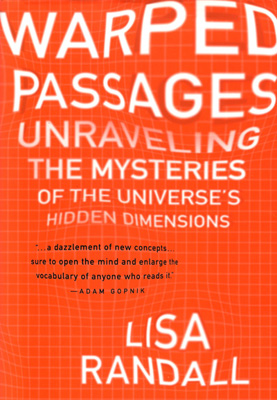
Let me summarize some of the introductory stuff about particles. I won’t give page references, but most of this is from Prof. Randall’s book, in particular the tables are copied pretty directly. In the Standard Model, particles come in three increasingly massive and increasingly rare generations or flavors, shown in the table below with twelve particles. Collectively the particles in the table are all known as fermions.
Each column contains particles with the same charge, sometimes spoken of as different flavors of the particle type. The first two entries in earch row are quarks, the last two are leptons. Only the quarks are subject to the strong force by the way.

Fermions
====
Charge: + 2/3, -1/3, 0, -1.
First Gen: up, down, electron neutrino, electron.
Second Gen: charm, strange, muon neutrino, muon.
Third Gen: top, bottom, tau neutrino, tau.
====
To make things worse, all the fermions except the neutrinos come in left and right handed forms — the neutrinos are only left-handed. So that’s 21 particles. Only the left-handed particles experience the weak force. The weak force can intercovert paired left-handed fermions .

And, for each fermion, there’s an antiparticle or antimatter form. So that’s 42 particles. And, each quark or antiquark comes in three colors: red, green or blue for the quarks, and antired, antigreen, and antiblue for the antiquarks. So since we already had 24 kinds of quarks (6 times two handednesses, doubled for matter/antimatter), we now really have three times that many quarks, making 90 kinds of fermions in all.
But maybe I'm exaggerating, we could, after all, view the properties as not making for entirely new particles and just say there's really just the two quarks, the neutrino, and the electron, and each of these comes in different generations or flavors, in different matter/antimatter modes, and in different handednesses.
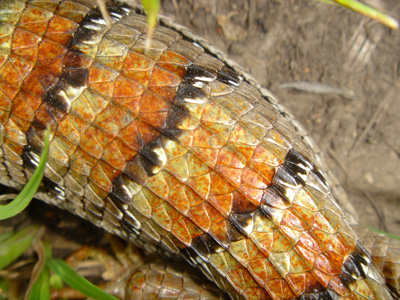
By the way, particles made from quarks (and their force-mediating gluons) are known as hadrons, thus the name of the planned “Large Hardon Supercollider,” whoops, “Large Hadron Supercollider.” The most familiar hadrons are in fact baryons, which are the hadrons made of three quarks, e.g. the proton made of two up quarks and a down quark, and e.g. the neutron made of one up quark and two down quarks. Mesons are made of one quark and one anti-quark. Examples of mesons are the pions (or pi mesons) and the K mesons.

Oh, as long as we’re counting particles, I need to mention that as well as the mass-like particles, there’s a whole other family of particles to mediate the exchanges of the four fundamental forces. The first three rows are collectively known as gauge bosons.
Bosons
====
Electromagnetic: photon
Weak : weak gauge bosons, W+, W-, and Z
Strong: gluons in eight of the nine possible color/anticolor combos.
Gravity: graviton
=====

So combining fermions and the, I think, 13 bosons, it looks like we have 103 particles (or, if we want to be conservative, 8 kind). As if this still weren’t confusing enough, there’s a theory called supersymmetry under which all the fermions (quarks and leptons) in the Standard Models are paired with bosonic superpartners; and the bosons are paired with fermionic superpartners . In this jabberwocky mirrormatch world we get these kinds of matches.
Superpartners
====
Particle, Corresponding Superpartner
electron, selectron
quark, squark
top quark, stop squark
photon, photino
W boson, wino
Z boson, zion
gluon , gluino
graviton, gravitino
====

So if everything has a partner, we’re looking at 206 particles now (or maybe 16). Oh, and you have to feed the Pigges as well, I mean the Higgs. What a mess. Are these people just putting us on? Do they know what they're talking about at all?
“In fact, because of the uncertainty principle, particles will do whatever they can get away with for as long as they can.” p. 226
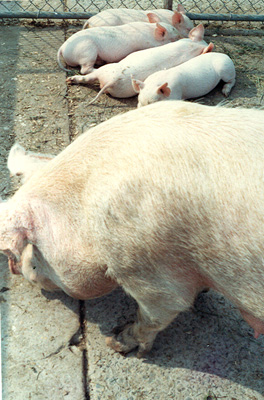
And, yeah, on top of everything else, there’s supposed to be a field called the Higgs field which carries with it a very massive particle called the Pigge Particle, stop that, I mean the Higgs particle. Well, maybe there’s two Higgs fields and a Higgs1 and a Higgs2 particle. Oh, and there better be a Higgs boson as well to mediate forces among the Higgs in the pen. Somehow the Higgs field explains why particles have mass at all. Speaking of mass, maybe the Higgs is associated with a very massive GUT particle of the “GUT scale mass, about one million billion GeV.” In symbols, that’s 10^15 GeV.
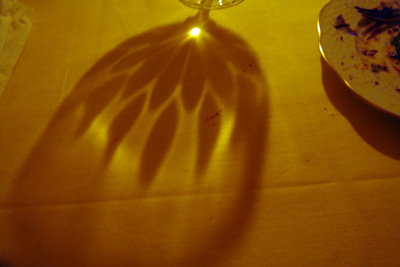
GUT stands for Grand Unified Theory, and the GUT mass is a mass/energy level at which the Weak, Strong, and Electromagnetic forces might melt together. Prof. Randall talks about the GUT scale mass a lot, by the way, but never says in plain words how heavy it is. Turns out a GeV (gigaelectronvolt) is about the same mass/energy as a proton or neutron at rest (the two are very close in mass). Now, the mass of proton is very roughly 2 x 10^(-27) kg. So if we multiply 10^15 times that, we get the fabulous beery blow-out let-it-all-hang-out GUT mass to be 2 x 10^(-12) kg, or 2 billionths of a gram. Two nanograms, and that’s heavy on the particle scale, some guys actually made a micrometer-scale silicon device that weighed in the nanogram range.

There’s an even heavier mass/energy level called the Planck energy, which is where gravity fuses with the other three forces and space and time melt like Dali watches. This is 10^19 GeV, ten thousand times the size of the GUT scale mass/energy, so that would be 20 micrograms. Note that Swiss chemist Albert Hofmann’s initial historic dose of acid was 250 micrograms. So the Planck mass is about the tenth of a hit of LSD. That’s all it takes to make space and time turn into wacky taffy! JK (just kidding), JK, JK, JK! “I am not a hippie.”
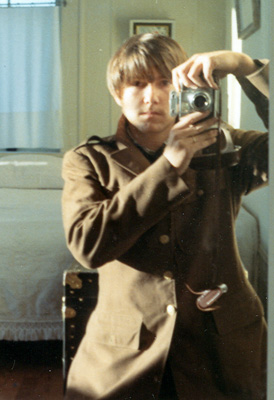
There are apparantly some vexing issues in particle theory these days. One problem has to do with supersymmetry breaking, another with why it is that the GUT mass and the Planck mass are so different. The difference has to do with gravity being so much weaker a force than the other three. Physics would look simpler if all four kinds of forces were about the same strength. Flavor-symmetry breaking is another problem…

One attempt to explain the proliferation of particles involves using strings made of curled hyperspace. The strings have a bunch of extra dimensions that the physicists waste by curling up or compactifying into tiny curls. Maybe 11 or 26 dimensions, counting the four of spacetime.
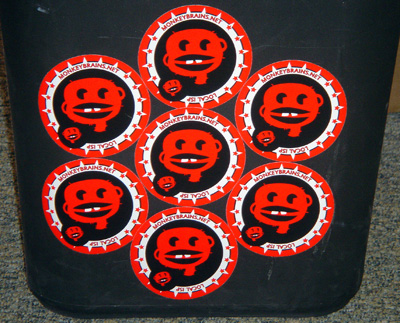
In what’s known as superstring theory, you can curl up the extra dimensions in different ways, and each method makes what’s called a Calabi-Yau manifold. The popular new theory is M-theory, an 11-dimensional theory which includes superstring theory and 11-dimensional supergravity. M might stand for magic, mystery, or membrane (or brane for short), even the inventor Ed Witten claims he isn’t sure. M-theory might be able to get away with only ten dimensions.

The tension of the strings or branes determines their mass and energy. But there’s no obvious bound to the tension, so we end up with more and more generations of fermions.
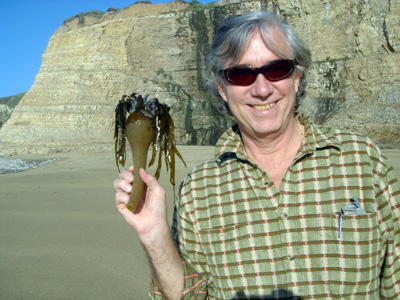
The vacuum energy of our cosmos is also known as the dark energy or the cosmological constant. It’s supposed to account for about 70% of the mass of the universe. And nobody knows what it is.

It could be that there exist two or more parallel branes, or sheets of spacetime with their concomitant rolled-up Calabi-Yau string dimensions. Our world could be the result of two tightly linked branes separated perhaps only by a tiny distance expressible in terms of the Plank length of 10^(-35) meters. The higher-dimensional space in between the branes is called — and I love this nomenclature — the bulk. What links the branes? Supposedly the graviton can move through the bulk between the two.

Bosons and fermions might be strings that stretch from one brane to the other, so-called open strings. The gravitons, on the other hand, could be closed strings, wrapped around in loops like bagels. That’s why gravitons can move through the bulk on their own, unlike all the other particles, which are like vibrating clotheslines across the bulk alley separating the neighboring brane buildings.

Lisa Randall is interested in braneworlds, that is, arrangements of branes that make some sense out of the current morass of particle physics.
Her first idea was to sequester all those weird superpartner particles off on a brane of their own, but very close to ours, perhaps only a few hundred Planck lengths off. She works with people with unusual names like Raman Sundrum, Graham Kribs and Zacharia Chacko.

She speculates that if the extra dimensions of string theory exist there should be still more particles called KK (for Kaluza-Klein) particles. A KK particle might consist, say of a closed string that’s wrapped around one of those extra dimensions like a rubber band on a toilet-paper roll.
Her favorite braneworld uses what she calls a warped dimension. As before we have our brane and another brane, which she calls, respectively, the Weakbrane and the Gravitybrane. They’re separated by a fourth spatial dimension or, if you prefer to put it another way, by a fifth dimension outside the four of spacetime. I’ll just think of it as the good old SFictional fourth dimension of A Square.
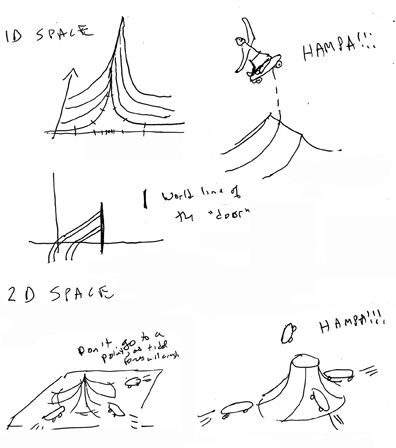
The gravitons spend most of their time on the Gravitybrane and only occasionally turn up on the Weakbrane, which is why gravity is so weak in our world. The fermions and bosons are, as usual, strings stretching between the two branes. I think here she wants to let the superpartners be in our world, too. The branes are quite close together again, only a few hundred multiples of the Planck length.

The warp factor has to do with a shrinking field that pervades the bulk space between the Weakbrane and the Gravitybrane: “objects getting bigger and lighter as you move away from the Gravitybrane and approach the Weakbrane,” p. 297. In effect, the Weakbrane is an exponentially stretched-out copy of the Gravitybrane, which is why gravity feels so weak in the Weakbrane. Here’s her Figure 82, p. 399.
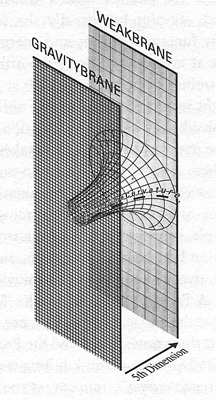
In my novel, I’m planning to speak of our home Weakbrane as the Mainbrane and of that other parallel other Gravitybrane universe as the Mirrorbrane.
It seems to me that that if a being travels through the bulk from the otherworldly Mirrorbrane or Gravitybrane to our home Weakbrane or Mainbrane, the creature will be very large and tenuous when they show up, with their path matching that of the trumpet-shape in the picture. They show up like a gauzy angel. Conversely if a being travels from our Mainbrane or Weakbrane to the Mirrorbrane or Gravitybrane, they arrive in a compact dense form: like a goblin.
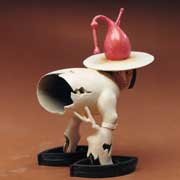
When we go to the Mirrorbrane, we’re small and denser than the things there. Gold bugs. When the Mirrorbraners come to us, they’re bigger and more tenuous than us. Like ghosts.

From a chapter of Warped Passages called “The Warped Annotated ‘Alice’”. “The [Cheshire Fat] Cat was keeping tabs on everything in the city, which was greatly facilitated by his skill at catching people unawares — especially surprising in light of the Cat’s enormous bulk. The cat loved to explain that he owed this skill to his ability to disappear into the bulk, but no one ever understood what he meant.” p. 415
The Cheshire Fat Cat is the graviton. But where’s that squealing Pigge particle? Wheenk, wheenk, wheenk.
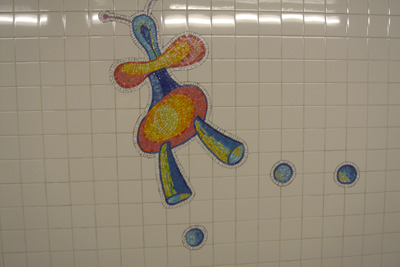
(Obscure picky comment: By the way, although I think Lisa Randall would agree with my notion of a person growing as they move from Gravitybrane to Weakbrane and shrinking when doing the opposite motion (judging from pp. 415-416), I think the caption to her Figure 85 (which is not the figure shown here but a different one in the book) must have mistakenly exchanged the words “Weakbrane” and “Gravitybrane”.) Well, in any case, I’m gonna warp it like I said.

Lisa Randall also suggests that we can do away with the Gravitybrane and simply have an infinite higher-dimensional bulk space with a certain kind of probability distribution for gravitons.
As an SF writer, it’s always gotten my goat how physicists help themselves to heaping platefuls of our long-sought after higher dimensions, and then can think of nothing better to do with them than curl them up in to Planck-length invisibility. I appreciate Lisa’s push to give us some big higher dimensions.
She also raises the possibility that space’s dimensionality might vary from location to location, and in closing mentions that, hey, we don’t really know what we even mean by a dimension.
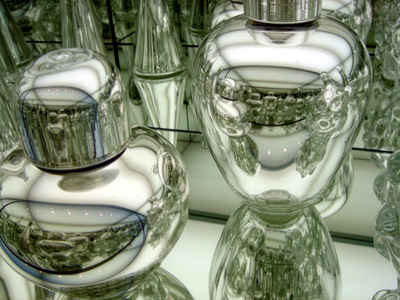
I need to change the amount of the size warp in the Warped Brane model. Lisa has the warp factor between the two branes being something really enormous, like ten to the seventeenth power. For my tale, it’d work better to have a simple factor of ten. The ghostly angelic Mirrorbraners are sixty feet tall; the dense, busy-body Earthlings in Hippieland are seven-inch vermin (seven inches is a tenth of 6 feet, that is, a tenth of 72 inches). Or maybe best would be one-foot humans and thirty-foot angels, a factor of six either way.

And what if the mass, just for the hell of it, goes the opposite way. I want my angels to be very aethereal, invisible, all but massless. And the earthling gnomes are intensely massive.
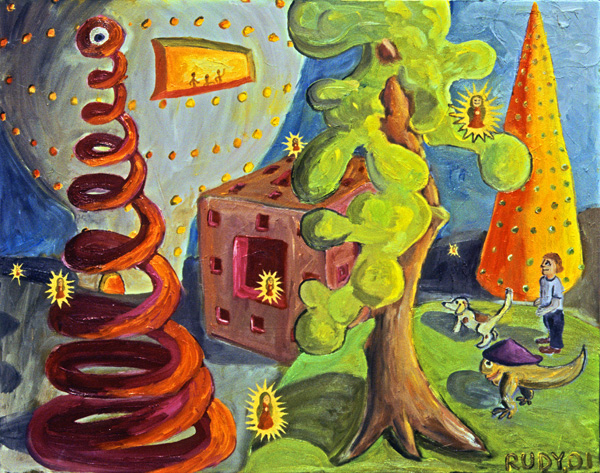









June 30th, 2007 at 1:03 am
particle size…
Hi. Very nice blog. I\’ve been reading your other entries all day long..lol….